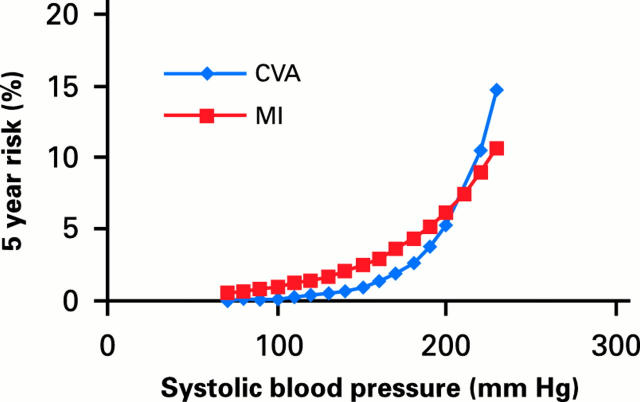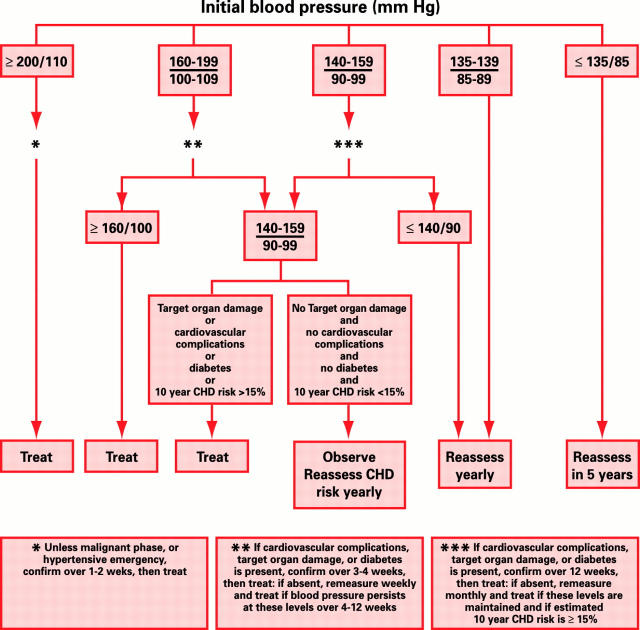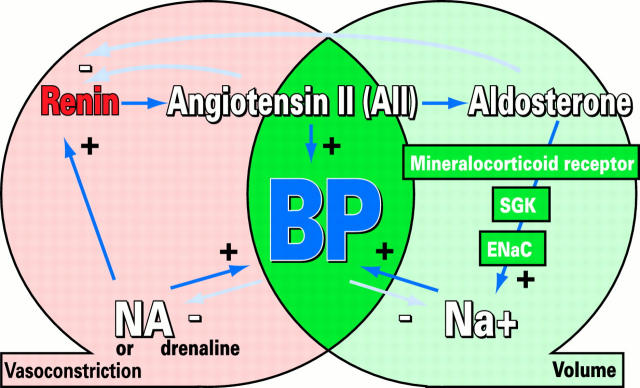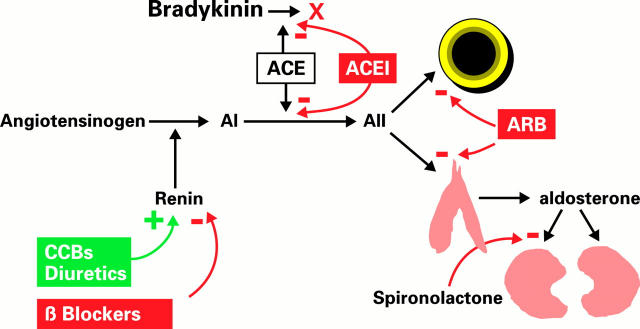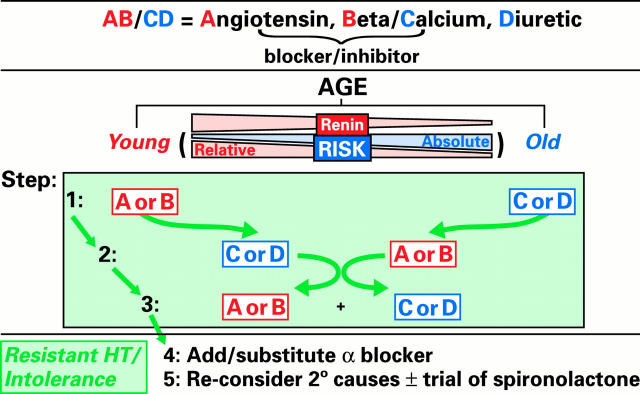Full Text
The Full Text of this article is available as a PDF (312.2 KB).
Figure 1: .
Absolute versus relative risk of myocardial infarction and stroke. Data from MacMahon et al2 and Collins et al3 are used to illustrate how myocardial infarction (MI) appears a more common complication of hypertension than stroke (cerebrovascular accident, CVA), because its incidence starts higher in the normal part of the blood pressure distribution. However, stroke has a higher relative risk (plotted as 40% v 25% for each 10 mm Hg increase in systolic blood pressure), and overtakes myocardial infarction as an absolute risk in severe hypertension.
Figure 2: .
Blood pressure indications for treatment (British Hypertension Society guidelines). Reproduced from Ramsay et al,4 with permission of BMJ Publishing Group.
Figure 3: .
NA or Na in hypertension? The principal initiating factors in hypertension are noradrenaline (NA) released from sympathetic nerves, which causes vasoconstriction, or sodium (Na+) which increases blood volume. Since blood pressure = peripheral resistance × cardiac output, hypertension cannot occur until vasoconstriction by noradrenaline and its stimulation of renin secretion fails to be offset by pressure natriuresis. Apart from the key players of NA, Na+, renin and angiotensin, there are a very large number of molecules involved in the synthesis, secretion or response to these, which provide candidate genes to explain inherited susceptibility to hypertension. The figure illustrates just three of these, relevant to the cell signalling of aldosterone. ENaC, epithelial sodium channel; SGK, serum glucocorticoid kinase.
Figure 4: .
Drugs acting on the renin-angiotensin-aldosterone system. Drugs which suppress the system are shown in red, those which activate the system are in green. ACEI, angiotensin converting enzyme inhibitor; ARB, angiotensin receptor blocker; CCBs, calcium channel blockers.
Figure 5: .
AB/CD schema for optimisation of antihypertensive treatment. In choosing initial treatment—step 1—age in a white population is used as a surrogate for plasma renin, which falls with age. The typical younger patient (aged < 55 years) responds better to ACE inhibition or β blockade, whereas in the older patient (aged > 55 years) calcium channel blockade or diuretic is the preferred starting treatment; angiotensin receptor blockade can substitute for ACE inhibition in intolerant patients. Because the response of patients to the two drugs within each pair is well correlated, there is usually no point in switching an unresponsive patient to the other of the pair (for example, A to B); therefore step 2 in such a patient is to switch to one of the other pair. If the blood pressure is still above target, step 3 is to combine one drug from each pair.
Selected References
These references are in PubMed. This may not be the complete list of references from this article.
- Appel L. J., Moore T. J., Obarzanek E., Vollmer W. M., Svetkey L. P., Sacks F. M., Bray G. A., Vogt T. M., Cutler J. A., Windhauser M. M. A clinical trial of the effects of dietary patterns on blood pressure. DASH Collaborative Research Group. N Engl J Med. 1997 Apr 17;336(16):1117–1124. doi: 10.1056/NEJM199704173361601. [DOI] [PubMed] [Google Scholar]
- Attwood S., Bird R., Burch K., Casadei B., Coats A., Conway J., Dawes M., Ebbs D., Farmer A., Robinson J. Within-patient correlation between the antihypertensive effects of atenolol, lisinopril and nifedipine. J Hypertens. 1994 Sep;12(9):1053–1060. [PubMed] [Google Scholar]
- Bidiville J., Nussberger J., Waeber G., Porchet M., Waeber B., Brunner H. R. Individual responses to converting enzyme inhibitors and calcium antagonists. Hypertension. 1988 Feb;11(2):166–173. doi: 10.1161/01.hyp.11.2.166. [DOI] [PubMed] [Google Scholar]
- Brown M. J., Castaigne A., de Leeuw P. W., Mancia G., Palmer C. R., Rosenthal T., Ruilope L. M. Influence of diabetes and type of hypertension on response to antihypertensive treatment. Hypertension. 2000 May;35(5):1038–1042. doi: 10.1161/01.hyp.35.5.1038. [DOI] [PubMed] [Google Scholar]
- Brown M. J., Dickerson J. E. Synergism between alpha 1-blockade and angiotensin converting enzyme inhibition in essential hypertension. J Hypertens Suppl. 1991 Dec;9(6):S362–S363. [PubMed] [Google Scholar]
- Brown M. J., Palmer C. R., Castaigne A., de Leeuw P. W., Mancia G., Rosenthal T., Ruilope L. M. Morbidity and mortality in patients randomised to double-blind treatment with a long-acting calcium-channel blocker or diuretic in the International Nifedipine GITS study: Intervention as a Goal in Hypertension Treatment (INSIGHT). Lancet. 2000 Jul 29;356(9227):366–372. doi: 10.1016/S0140-6736(00)02527-7. [DOI] [PubMed] [Google Scholar]
- Bühler F. R., Burkart F., Lütold B. E., Küng M., Marbet G., Pfisterer M. Antihypertensive beta blocking action as related to renin and age: a pharmacologic tool to identify pathogenetic mechanisms in essential hypertension. Am J Cardiol. 1975 Oct 31;36(5):653–669. doi: 10.1016/0002-9149(75)90168-x. [DOI] [PubMed] [Google Scholar]
- Colhoun H. M., Dong W., Poulter N. R. Blood pressure screening, management and control in England: results from the health survey for England 1994. J Hypertens. 1998 Jun;16(6):747–752. doi: 10.1097/00004872-199816060-00005. [DOI] [PubMed] [Google Scholar]
- Collins R., Peto R., MacMahon S., Hebert P., Fiebach N. H., Eberlein K. A., Godwin J., Qizilbash N., Taylor J. O., Hennekens C. H. Blood pressure, stroke, and coronary heart disease. Part 2, Short-term reductions in blood pressure: overview of randomised drug trials in their epidemiological context. Lancet. 1990 Apr 7;335(8693):827–838. doi: 10.1016/0140-6736(90)90944-z. [DOI] [PubMed] [Google Scholar]
- Dickerson J. E., Brown M. J. Influence of age on general practitioners' definition and treatment of hypertension. BMJ. 1995 Mar 4;310(6979):574–574. doi: 10.1136/bmj.310.6979.574. [DOI] [PMC free article] [PubMed] [Google Scholar]
- Dickerson J. E., Hingorani A. D., Ashby M. J., Palmer C. R., Brown M. J. Optimisation of antihypertensive treatment by crossover rotation of four major classes. Lancet. 1999 Jun 12;353(9169):2008–2013. doi: 10.1016/s0140-6736(98)07614-4. [DOI] [PubMed] [Google Scholar]
- Forette F., Seux M. L., Staessen J. A., Thijs L., Birkenhäger W. H., Babarskiene M. R., Babeanu S., Bossini A., Gil-Extremera B., Girerd X. Prevention of dementia in randomised double-blind placebo-controlled Systolic Hypertension in Europe (Syst-Eur) trial. Lancet. 1998 Oct 24;352(9137):1347–1351. doi: 10.1016/s0140-6736(98)03086-4. [DOI] [PubMed] [Google Scholar]
- Franklin S. S., Khan S. A., Wong N. D., Larson M. G., Levy D. Is pulse pressure useful in predicting risk for coronary heart Disease? The Framingham heart study. Circulation. 1999 Jul 27;100(4):354–360. doi: 10.1161/01.cir.100.4.354. [DOI] [PubMed] [Google Scholar]
- Geller D. S., Farhi A., Pinkerton N., Fradley M., Moritz M., Spitzer A., Meinke G., Tsai F. T., Sigler P. B., Lifton R. P. Activating mineralocorticoid receptor mutation in hypertension exacerbated by pregnancy. Science. 2000 Jul 7;289(5476):119–123. doi: 10.1126/science.289.5476.119. [DOI] [PubMed] [Google Scholar]
- Gordon R. D., Stowasser M., Tunny T. J., Klemm S. A., Rutherford J. C. High incidence of primary aldosteronism in 199 patients referred with hypertension. Clin Exp Pharmacol Physiol. 1994 Apr;21(4):315–318. doi: 10.1111/j.1440-1681.1994.tb02519.x. [DOI] [PubMed] [Google Scholar]
- Grimm R. H., Jr, Grandits G. A., Cutler J. A., Stewart A. L., McDonald R. H., Svendsen K., Prineas R. J., Liebson P. R. Relationships of quality-of-life measures to long-term lifestyle and drug treatment in the Treatment of Mild Hypertension Study. Arch Intern Med. 1997 Mar 24;157(6):638–648. [PubMed] [Google Scholar]
- Hansson L., Hedner T., Lund-Johansen P., Kjeldsen S. E., Lindholm L. H., Syvertsen J. O., Lanke J., de Faire U., Dahlöf B., Karlberg B. E. Randomised trial of effects of calcium antagonists compared with diuretics and beta-blockers on cardiovascular morbidity and mortality in hypertension: the Nordic Diltiazem (NORDIL) study. Lancet. 2000 Jul 29;356(9227):359–365. doi: 10.1016/s0140-6736(00)02526-5. [DOI] [PubMed] [Google Scholar]
- Hansson L., Lindholm L. H., Ekbom T., Dahlöf B., Lanke J., Scherstén B., Wester P. O., Hedner T., de Faire U. Randomised trial of old and new antihypertensive drugs in elderly patients: cardiovascular mortality and morbidity the Swedish Trial in Old Patients with Hypertension-2 study. Lancet. 1999 Nov 20;354(9192):1751–1756. doi: 10.1016/s0140-6736(99)10327-1. [DOI] [PubMed] [Google Scholar]
- Hansson L., Lindholm L. H., Niskanen L., Lanke J., Hedner T., Niklason A., Luomanmäki K., Dahlöf B., de Faire U., Mörlin C. Effect of angiotensin-converting-enzyme inhibition compared with conventional therapy on cardiovascular morbidity and mortality in hypertension: the Captopril Prevention Project (CAPPP) randomised trial. Lancet. 1999 Feb 20;353(9153):611–616. doi: 10.1016/s0140-6736(98)05012-0. [DOI] [PubMed] [Google Scholar]
- Hansson L. The Hypertension Optimal Treatment study and the importance of lowering blood pressure. J Hypertens Suppl. 1999 Feb;17(1):S9–13. [PubMed] [Google Scholar]
- Hansson L., Zanchetti A., Carruthers S. G., Dahlöf B., Elmfeldt D., Julius S., Ménard J., Rahn K. H., Wedel H., Westerling S. Effects of intensive blood-pressure lowering and low-dose aspirin in patients with hypertension: principal results of the Hypertension Optimal Treatment (HOT) randomised trial. HOT Study Group. Lancet. 1998 Jun 13;351(9118):1755–1762. doi: 10.1016/s0140-6736(98)04311-6. [DOI] [PubMed] [Google Scholar]
- Laragh J. H., Lamport B., Sealey J., Alderman M. H. Diagnosis ex juvantibus. Individual response patterns to drugs reveal hypertension mechanisms and simplify treatment. Hypertension. 1988 Sep;12(3):223–226. doi: 10.1161/01.hyp.12.3.223. [DOI] [PubMed] [Google Scholar]
- Laragh J. H., Letcher R. L., Pickering T. G. Renin profiling for diagnosis and treatment of hypertension. JAMA. 1979 Jan 12;241(2):151–156. [PubMed] [Google Scholar]
- Lifton R. P., Dluhy R. G., Powers M., Rich G. M., Cook S., Ulick S., Lalouel J. M. A chimaeric 11 beta-hydroxylase/aldosterone synthase gene causes glucocorticoid-remediable aldosteronism and human hypertension. Nature. 1992 Jan 16;355(6357):262–265. doi: 10.1038/355262a0. [DOI] [PubMed] [Google Scholar]
- Lim P. O., Rodgers P., Cardale K., Watson A. D., MacDonald T. M. Potentially high prevalence of primary aldosteronism in a primary-care population. Lancet. 1999 Jan 2;353(9146):40–40. doi: 10.1016/S0140-6736(05)74868-6. [DOI] [PubMed] [Google Scholar]
- Lund-Johansen P. Twenty-year follow-up of hemodynamics in essential hypertension during rest and exercise. Hypertension. 1991 Nov;18(5 Suppl):III54–III61. doi: 10.1161/01.hyp.18.5_suppl.iii54. [DOI] [PubMed] [Google Scholar]
- MacMahon S., Peto R., Cutler J., Collins R., Sorlie P., Neaton J., Abbott R., Godwin J., Dyer A., Stamler J. Blood pressure, stroke, and coronary heart disease. Part 1, Prolonged differences in blood pressure: prospective observational studies corrected for the regression dilution bias. Lancet. 1990 Mar 31;335(8692):765–774. doi: 10.1016/0140-6736(90)90878-9. [DOI] [PubMed] [Google Scholar]
- Materson B. J., Reda D. J., Cushman W. C., Massie B. M., Freis E. D., Kochar M. S., Hamburger R. J., Fye C., Lakshman R., Gottdiener J. Single-drug therapy for hypertension in men. A comparison of six antihypertensive agents with placebo. The Department of Veterans Affairs Cooperative Study Group on Antihypertensive Agents. N Engl J Med. 1993 Apr 1;328(13):914–921. doi: 10.1056/NEJM199304013281303. [DOI] [PubMed] [Google Scholar]
- Ménard J., Serrurier D., Bautier P., Plouin P. F., Corvol P. Crossover design to test antihypertensive drugs with self-recorded blood pressure. Hypertension. 1988 Feb;11(2):153–159. doi: 10.1161/01.hyp.11.2.153. [DOI] [PubMed] [Google Scholar]
- Philipp T., Anlauf M., Distler A., Holzgreve H., Michaelis J., Wellek S. Randomised, double blind, multicentre comparison of hydrochlorothiazide, atenolol, nitrendipine, and enalapril in antihypertensive treatment: results of the HANE study. HANE Trial Research Group. BMJ. 1997 Jul 19;315(7101):154–159. doi: 10.1136/bmj.315.7101.154. [DOI] [PMC free article] [PubMed] [Google Scholar]
- Ramsay L. E., Williams B., Johnston G. D., MacGregor G. A., Poston L., Potter J. F., Poulter N. R., Russell G. British Hypertension Society guidelines for hypertension management 1999: summary. BMJ. 1999 Sep 4;319(7210):630–635. doi: 10.1136/bmj.319.7210.630. [DOI] [PMC free article] [PubMed] [Google Scholar]
- Sever P. Abandoning diastole . BMJ. 1999 Jun 26;318(7200):1773–1773. doi: 10.1136/bmj.318.7200.1773. [DOI] [PMC free article] [PubMed] [Google Scholar]
- Sharma P., Fatibene J., Ferraro F., Jia H., Monteith S., Brown C., Clayton D., O'Shaughnessy K., Brown M. J. A genome-wide search for susceptibility loci to human essential hypertension. Hypertension. 2000 Jun;35(6):1291–1296. doi: 10.1161/01.hyp.35.6.1291. [DOI] [PubMed] [Google Scholar]
- Shimkets R. A., Warnock D. G., Bositis C. M., Nelson-Williams C., Hansson J. H., Schambelan M., Gill J. R., Jr, Ulick S., Milora R. V., Findling J. W. Liddle's syndrome: heritable human hypertension caused by mutations in the beta subunit of the epithelial sodium channel. Cell. 1994 Nov 4;79(3):407–414. doi: 10.1016/0092-8674(94)90250-x. [DOI] [PubMed] [Google Scholar]
- Stewart P. M., Krozowski Z. S., Gupta A., Milford D. V., Howie A. J., Sheppard M. C., Whorwood C. B. Hypertension in the syndrome of apparent mineralocorticoid excess due to mutation of the 11 beta-hydroxysteroid dehydrogenase type 2 gene. Lancet. 1996 Jan 13;347(8994):88–91. doi: 10.1016/s0140-6736(96)90211-1. [DOI] [PubMed] [Google Scholar]
- Stewart P. M. Mineralocorticoid hypertension. Lancet. 1999 Apr 17;353(9161):1341–1347. doi: 10.1016/S0140-6736(98)06102-9. [DOI] [PubMed] [Google Scholar]
- Yusuf S., Sleight P., Pogue J., Bosch J., Davies R., Dagenais G. Effects of an angiotensin-converting-enzyme inhibitor, ramipril, on cardiovascular events in high-risk patients. The Heart Outcomes Prevention Evaluation Study Investigators. N Engl J Med. 2000 Jan 20;342(3):145–153. doi: 10.1056/NEJM200001203420301. [DOI] [PubMed] [Google Scholar]



